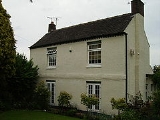
Loscoe
Encyclopedia
Loscoe is a small village near Heanor
in Derbyshire
, England
.
The research for Highfield House dates back to 1650 or possibly as early as 1630. This may now be the oldest surviving house in Loscoe as many houses in the village were demolished due to subsidence.
explosion on 24 March 1986. Although there were no fatalities, one house was completely destroyed by the blast and the three occupants injured. On the night of the explosion the atmospheric air pressure fell 29 hPa
(29 mbar
) over a 7 hour period, causing the gas to be released from the ground in much greater quantities than usual. In the four hours before the explosion, which occurred at approximately 6.30am, the local meteorological office
had recorded average falls of 4 hPa (4 mbar) per hour. Several cubic metres of landfill gas
(consisting of a 3:2 mixture of methane
and carbon dioxide
) collected under the ground near 51 Clarke Avenue and as the gas expanded it flowed into the space beneath the floor from where it was drawn by convection to the gas central heating boiler and ignited.
This disaster led (in Britain
) to the introduction of key legislation and government guidance and much research into landfill behaviour and best practice at landfill sites. Over time, these were designed to vent gas to atmosphere, then to burn off methane and eventually in the most productive, to turn the gas into electricity using gas turbines which supply the national grid.
Heanor
Heanor is a town in the Amber Valley district of Derbyshire in the East Midlands of England. It is northeast of Derby. According to the census of 2001 the town's population was 22,620.-History:...
in Derbyshire
Derbyshire
Derbyshire is a county in the East Midlands of England. A substantial portion of the Peak District National Park lies within Derbyshire. The northern part of Derbyshire overlaps with the Pennines, a famous chain of hills and mountains. The county contains within its boundary of approx...
, England
England
England is a country that is part of the United Kingdom. It shares land borders with Scotland to the north and Wales to the west; the Irish Sea is to the north west, the Celtic Sea to the south west, with the North Sea to the east and the English Channel to the south separating it from continental...
.
The research for Highfield House dates back to 1650 or possibly as early as 1630. This may now be the oldest surviving house in Loscoe as many houses in the village were demolished due to subsidence.
1986 landfill gas explosion
Loscoe was the site of a landfill gas migrationLandfill gas migration
Landfill gas migration is a complex process of the gas moving from the site of original deposition to other places via diffusion. Usually, the gas moves from areas of high concentration to areas of low gas concentration around a landfill. The process is also affected by the permeability of the...
explosion on 24 March 1986. Although there were no fatalities, one house was completely destroyed by the blast and the three occupants injured. On the night of the explosion the atmospheric air pressure fell 29 hPa
Pascal (unit)
The pascal is the SI derived unit of pressure, internal pressure, stress, Young's modulus and tensile strength, named after the French mathematician, physicist, inventor, writer, and philosopher Blaise Pascal. It is a measure of force per unit area, defined as one newton per square metre...
(29 mbar
Bar (unit)
The bar is a unit of pressure equal to 100 kilopascals, and roughly equal to the atmospheric pressure on Earth at sea level. Other units derived from the bar are the megabar , kilobar , decibar , centibar , and millibar...
) over a 7 hour period, causing the gas to be released from the ground in much greater quantities than usual. In the four hours before the explosion, which occurred at approximately 6.30am, the local meteorological office
Met Office
The Met Office , is the United Kingdom's national weather service, and a trading fund of the Department for Business, Innovation and Skills...
had recorded average falls of 4 hPa (4 mbar) per hour. Several cubic metres of landfill gas
Landfill gas
Landfill gas is a complex mix of different gases created by the action of microorganisms within a landfill.-Production:Landfill gas production results from chemical reactions and microbes acting upon the waste as the putrescible materials begins to break down in the landfill...
(consisting of a 3:2 mixture of methane
Methane
Methane is a chemical compound with the chemical formula . It is the simplest alkane, the principal component of natural gas, and probably the most abundant organic compound on earth. The relative abundance of methane makes it an attractive fuel...
and carbon dioxide
Carbon dioxide
Carbon dioxide is a naturally occurring chemical compound composed of two oxygen atoms covalently bonded to a single carbon atom...
) collected under the ground near 51 Clarke Avenue and as the gas expanded it flowed into the space beneath the floor from where it was drawn by convection to the gas central heating boiler and ignited.
This disaster led (in Britain
United Kingdom
The United Kingdom of Great Britain and Northern IrelandIn the United Kingdom and Dependencies, other languages have been officially recognised as legitimate autochthonous languages under the European Charter for Regional or Minority Languages...
) to the introduction of key legislation and government guidance and much research into landfill behaviour and best practice at landfill sites. Over time, these were designed to vent gas to atmosphere, then to burn off methane and eventually in the most productive, to turn the gas into electricity using gas turbines which supply the national grid.

